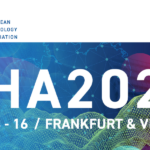
Director of the Oncology Diagnosis and Treatment Center, Tianjin People’s Hospital of Nankai University
From June 8th to 11th, 2023, the 28th European Hematology Association Congress (EHA) will take place in Frankfurt, Germany, in both online and offline formats, organized by the European Hematology Society. As the largest international conference in the field of European hematology, the EHA Congress will cover various scientific topics, clinical and basic research, benign and malignant hematology, and discuss the latest developments in the field of hematology.
At this year’s EHA Congress, a study from Italy (abstract S231) explored the differences in the efficacy and survival outcomes of CAR-T cell therapy for different subtypes of B-cell lymphoma patients, drawing significant attention. To gain a deeper understanding of this study, Oncology Frontier conducted an exclusive interview with Professor Wang Huaqing from Tianjin People’s Hospital of Nankai University, who provided detailed insights into the research.
Abstract: S231
Title: PRIMARY MEDIASTINAL B-CELL LYMPHOMA HAVE A SUPERIOR OUTCOME COMPARED TO DIFFUSE LARGE-B-CELL LYMPHOMA TREATED WITH AXICABTAGENE CILOLEUCEL IN THE CART-SIE REAL LIFE ITALIAN STUDY
CART-SIE is an ongoing prospective, retrospective observational study collecting efficacy outcomes of patients treated with CAR-T cell therapy across various medical centers in Italy.
Between March 2019 and December 2022, a total of 499 patients were enrolled in the study, with 444 receiving CAR-T cell infusion therapy, and 426 undergoing long-term follow-up. Among the 192 patients treated with axi-cel infusion, 57 had PMBCL, and 135 had DLBCL (including 85 DLBCL-NOS, 28 HGBCL, and 22 tFL cases).
With a median follow-up of 10.99 months, the results showed:
1. After 30 days of axi-cel infusion therapy, in 57 PMBCL patients, the objective response rate (ORR) reached 77% (44/57), with a complete response rate (CR) of 53% (30/57). In 135 DLBCL patients, the ORR was 72% (97/135), with a CR of 50% (67/135), p=0.4206.
2. Regarding survival, the 12-month overall survival (OS) for PMBCL patients was 89%, compared to 70% for DLBCL patients (including DLBCL-NOS at 74%, HGBCL at 58%, and tFL at 76%), p=0.0016. The 12-month progression-free survival (PFS) for PMBCL patients was 65%, while for DLBCL patients, it was 47% (DLBCL-NOS at 40%, HGBCL at 51%, tFL at 65%), p=0.016.
In terms of safety:
1. The cytokine release syndrome (CRS) incidence in PMBCL patients was 86% (49/57), with 16% (9/57) experiencing grade 3-4 CRS. In DLBCL patients, the CRS incidence was 87% (118/135), with 9% (12/135) experiencing grade 3-4 CRS.
2. Immune effector cell-associated neurotoxicity syndrome (ICANS) incidence in PMBCL patients was 44% (25/57), with 21% (12/57) experiencing grade 3-4 ICANS. In DLBCL patients, the ICANS incidence was 34% (46/135), with 10% (14/135) experiencing grade 3-4 ICANS.
3. In PMBCL patients, 72% (41/57) of adverse events were managed with tocilizumab, while 35% (20/57) were managed with corticosteroids. In DLBCL patients, 67% (90/135) were managed with tocilizumab, and 27% (36/135) were managed with corticosteroids.
4. Treatment-related mortality rates were 5% for PMBCL and 2% for DLBCL patients.
Dr. Huaqing Wang’s Commentary:
This is a clinical study from Italy presented at the EHA Congress, which primarily investigates the real-world application of CAR-T cell therapy (axi-cel) in patients with diffuse large B-cell lymphoma-not otherwise specified (DLBCL-NOS), primary mediastinal B-cell lymphoma (PMBCL), high-grade B-cell lymphoma (HGBCL), and transformed follicular lymphoma (tFL). Currently, CAR-T cell therapy is mainly used for the treatment of relapsed/refractory lymphomas. However, for B-cell lymphoma subtypes with high-risk factors, it is also recommended as a first-line treatment. Determining which lymphoma subtypes benefit most from CAR-T cell therapy is an important topic of investigation, and this study explores this question.
The study included 499 patients from various medical centers in Italy between March 2019 and December 2022, with 192 of them receiving axi-cel cell infusions (57 PMBCL and 135 DLBCL patients). PMBCL patients showed a 77% objective response rate (ORR) and a 53% complete response rate (CR) 30 days after axi-cel treatment, while DLBCL patients had a 72% ORR and a 50% CR, with no statistically significant difference in treatment efficacy between the two groups. However, the 1-year survival rates differed significantly, with PMBCL patients having a 1-year OS of 89% and a 1-year PFS of 65%, both higher than DLBCL patients (1-year OS at 70% and 1-year PFS at 47%), with p-values of 0.0016 and 0.016, respectively. This suggests that PMBCL patients may benefit more from axi-cel treatment in terms of efficacy and survival outcomes. Notably, there were also significant survival differences within the DLBCL group based on subtypes.
In terms of safety, the study reported similar rates of CRS and ICANS in PMBCL and DLBCL patients. CRS was manageable with tocilizumab and corticosteroids in both groups, with a slightly higher incidence of grade 3-4 CRS in PMBCL patients. The treatment-related mortality rates were 5% for PMBCL and 2% for DLBCL patients.
In summary, this study suggests that PMBCL may benefit more from axi-cel treatment compared to DLBCL (including DLBCL-NOS, HGBCL, and tFL) in terms of better prognosis. Therefore, early application of axi-cel treatment is recommended for PMBCL patients, especially those with bulky disease, primary refractoriness, and high-risk adverse prognostic factors.



